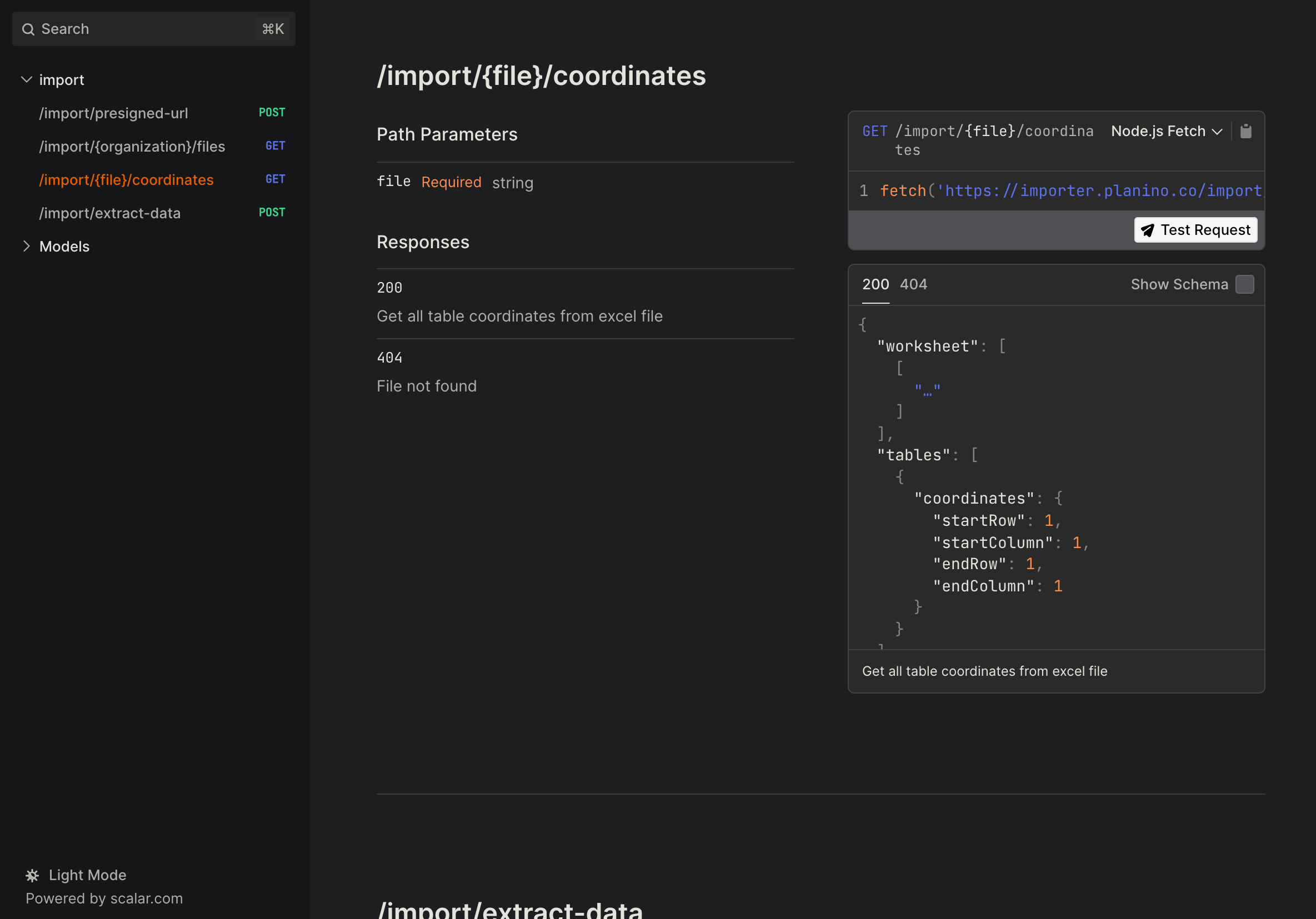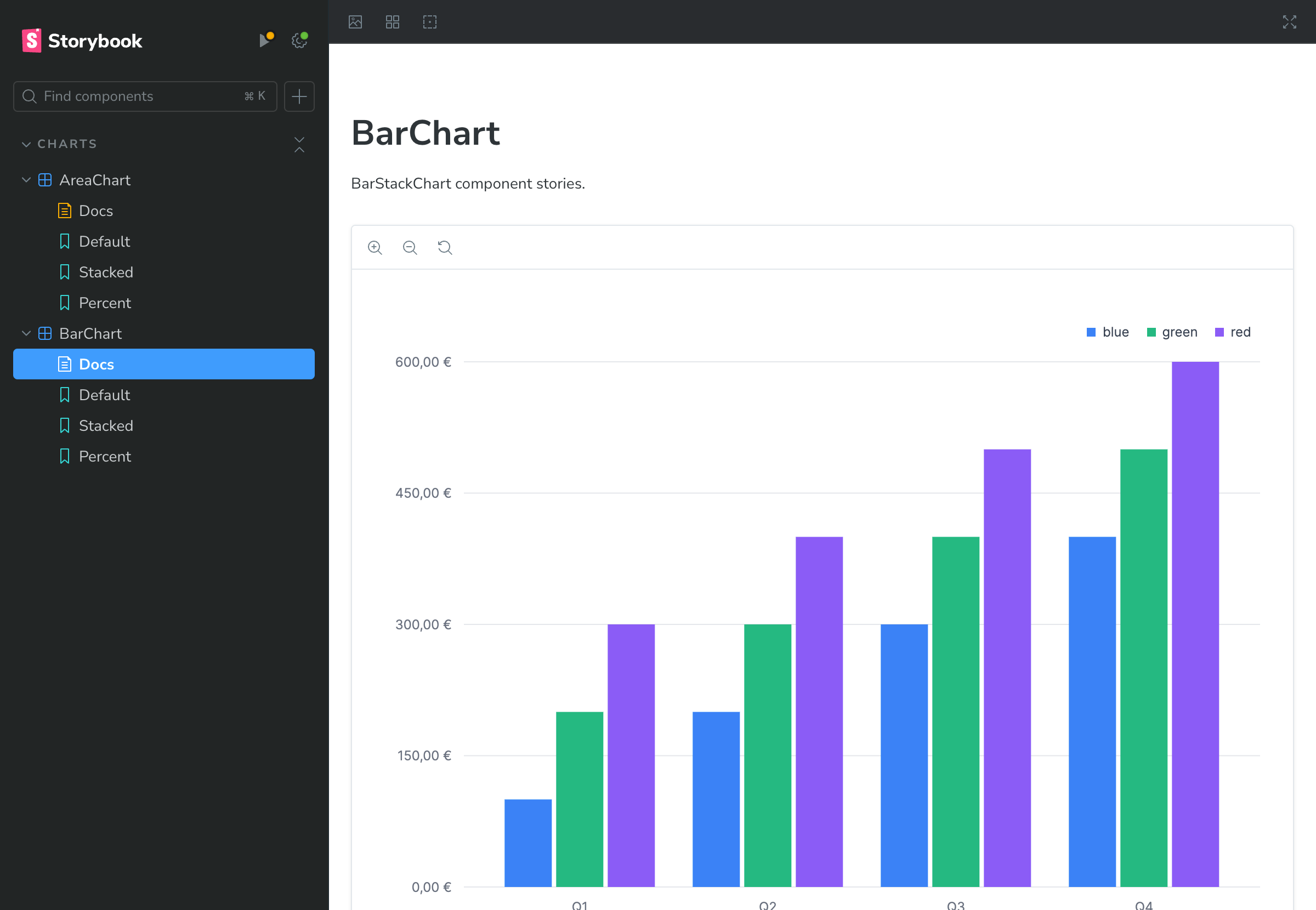- Summary for README
- Application Structure
- Application Infrastructure
- Dashboard Application Routes
- API Documentation
- Storybook for Chart Components
- Database
Planino Application is designed to help startups and SMEs create business plans and calculate breakeven points. The platform provides an accessible, user-friendly interface for visualizing financial data, importing Excel data, and generating business plans. Key features include detailed cost analysis, profit forecasting, AI-assisted projections, and scenario management. Target users include SMEs, students, consultants, and financial institutions. The application is available through a web app with a freemium model, offering advanced functionalities via subscription.
| Strengths | Weaknesses | Opportunities | Threats |
|---|---|---|---|
| User-friendly interface | High initial development cost | Expanding SME market | Competition from established software |
| Detailed cost analysis | Requires user data input | Partnerships with financial institutions | Rapid changes in financial regulations |
| AI-assisted projections | Limited market awareness | Growing demand for financial planning tools | Dependence on technology infrastructure |
| Scenario management |
The project is organized as a "monorepo," a modern approach that allows centralized management of multiple projects within a single repository. This format simplifies development, maintenance, and scaling of applications.
The monorepo is divided into two main segments: application directories and package directories. The application directory contains user applications like "Importer" and "Dashboard," which are intended for user interaction. The package directory includes support for applications, such as "Database Package" for database interaction and "ESLint Shared Config" for ensuring code quality.
This approach enables better coordination, easier version control, and faster implementation of changes, promoting modularity and code reuse. Additionally, there are shared configurations for ESLint, Tailwind CSS, TypeScript, charts, and database packages.
graph TD;
A[Monorepo] --> B[Application Directories]
A[Monorepo] --> C[Package Directories]
B[Application Directories] --> D[Importer]
B[Application Directories] --> E[Dashboard]
C[Package Directories] --> F[Database Package]
C[Package Directories] --> G[ESLint Shared Config]
C[Package Directories] --> H[Shared Tailwind Config]
C[Package Directories] --> I[Shared TypeScript Config]
C[Package Directories] --> J[Charts Package]
C[Package Directories] --> K[Database Packages]
E --> F
E --> G
E --> H
E --> I
E --> J
E --> K
D --> G
D --> I
J --> G
J --> H
J --> I
style A fill:#f9f,stroke:#333,stroke-width:4px;
style B fill:#bbf,stroke:#333,stroke-width:2px;
style C fill:#bbf,stroke:#333,stroke-width:2px;
style D fill:#bbf,stroke:#333,stroke-width:2px;
style E fill:#bbf,stroke:#333,stroke-width:2px;
style F fill:#bbf,stroke:#333,stroke-width:2px;
style G fill:#bbf,stroke:#333,stroke-width:2px;
style H fill:#bbf,stroke:#333,stroke-width:2px;
style I fill:#bbf,stroke:#333,stroke-width:2px;
style J fill:#bbf,stroke:#333,stroke-width:2px;
style K fill:#bbf,stroke:#333,stroke-width:2px;
The infrastructure used in the application is carefully designed to enable efficient and secure interaction between various components across multiple platforms. It consists of the following key elements:
- Next.js Dashboard: The frontend part of the application built with Next.js, hosted on the Vercel platform. This part of the application provides the user interface through which users can effectively use the application’s functionalities.
- Importer API: A backend API implemented on the Cloudflare Workers platform. This API handles business logic, database communication, and file management.
- PostgreSQL Database: The primary database used to store all relevant data required for the application’s functionality. PostgreSQL is a robust, scalable relational database that supports complex queries and transactions.
- Cloudflare R2 Storage: A storage space for files, integrated with the Importer API on the Cloudflare platform. R2 Storage provides high availability and performance for storage and retrieval operations.
The following diagram illustrates how these components connect and communicate within the infrastructure:
graph TD;
A[Next.js Dashboard] -->|API Calls| B[Importer API]
B[Importer API] -->|Reads/Writes| C[PostgreSQL Database]
B[Importer API] -->|Stores/Retrieves Files| D[Cloudflare R2 Storage]
A -->|Fetches Data| C
A -->|Fetches Files| D
style A fill:#f9f,stroke:#333,stroke-width:2px;
style B fill:#bbf,stroke:#333,stroke-width:2px;
style C fill:#bbf,stroke:#333,stroke-width:2px;
style D fill:#bbf,stroke:#333,stroke-width:2px;
The root route is "/[organization]", which serves as the main entry point into the application for a specific organization. From this point, users can navigate through various sub-routes that provide specific functionalities or display certain data.
- /cijena-i-kolicina: View and manage information about product prices and quantities. The sub-route /[productId] provides a detailed view of a specific product.
- /imovina-i-oprema: Overview and management of information about the organization’s assets and equipment.
- /odjeli: Viewing and managing data about different departments within the organization.
- /operativni-troskovi: Access and manage information about the organization’s operational costs.
- /podatci: Main route for managing various data sets within the organization, with sub-routes /pregled for data review and /uvoz for importing new data.
- /poslovni-planovi: Access and manage business plans, with a detailed view of a specific plan through the sub-route /[businessPlanId].
- /otplatni-planovi: Manage repayment plans for loans and other financial commitments.
- /prihodi: View and manage information about the organization's income.
- /racun-dobiti-i-gubitka: Access the profit and loss account of the organization.
- /tocka-pokrica: Manage and review the breakeven point analysis.
- /troskovi: Access and manage various costs associated with the organization.
The Importer API is designed for efficient processing and management of data imports for various organizations. It enables secure transfer and manipulation of files, as well as access to specific information within those files. Full documentation can be found at importer.planino.co/reference.
Description: Generate presigned URLs for importing data.
Description: Retrieve all Excel files from an organization's bucket.
Description: Generate coordinates and tables for given file.
Storybook is used in the Planino application to develop and showcase chart components in isolation. It allows for interactive testing, immediate visualization of changes, and comprehensive documentation of each component.
The database contains a series of tables that are interconnected to enable efficient data management within the organization. Each table has its specific role and is connected to other tables to ensure integration and consolidation of information.
- Users (users): This table contains basic information about users, including their ID, name, email address, email verification date, and profile picture. The email address is mandatory for all users.
- Accounts (accounts): This table stores data about different accounts associated with users. This includes account type, service provider, provider ID, and token data with expiration dates.
- Sessions (sessions): The sessions table stores information about active user sessions, including session tokens and expiration dates.
- Organizations (organizations): Each organization in the database has its unique identifier, name, and is linked to the user who created it. Organizations can have associated credits, teams, business plans, and product groups.
- Teams (teams): Teams are grouped within organizations and have their data such as ID, creation date, and name.
- Members (members): This table stores information about members of teams, including their ID, name, role, salary, and employment duration.
- Loans (loans): The loans table records information about loans taken by organizations, including the loan amount, interest rate, duration, and start date.
- Financial Attributes (financialAttributes), Expense Frequencies (expenseFrequencies), and Expense Types (expenseTypes): These tables enable detailed tracking of costs and financial attributes associated with teams and expenses.
- Expenses (expenses): This table tracks specific expenses within teams, linking them to appropriate financial attributes, frequencies, and expense types.
- Inventory Items (inventoryItems): This table is used for managing inventory within teams, including details such as value and depreciation period.
- Business Plans (businessPlans): These tables allow organizations to structure and store their business plans and plan contents.
- Product Groups (productGroups) and Products (products): Managing products and product groups allows organizations to organize their products and track their price history.
- Product Price History (productPriceHistory): This table records the price history of products, including unit count, unit expense, and unit price at different times.
- Imported Files (importedFiles): This table stores information about files imported into the system, including the file's name and content.
- Imported Tables (importedTables): This table stores data extracted from imported files, including the table's coordinates, headers, and values.
erDiagram
USERS {
text id PK
text name
text email
timestamp emailVerified
text image
}
ACCOUNTS {
text userId FK
text type
text provider
text providerAccountId
text refresh_token
text access_token
int expires_at
text token_type
text scope
text id_token
text session_state
}
SESSIONS {
text sessionToken PK
text userId FK
timestamp expires
}
ORGANIZATIONS {
uuid organizationId PK
timestamp createdAt
text name
text slug
text userId FK
}
TEAMS {
uuid teamId PK
timestamp createdAt
text name
uuid organizationId FK
}
MEMBERS {
uuid memberId PK
timestamp createdAt
timestamp updatedAt
text name
text role
timestamp startingMonth
timestamp endingMonth
numeric salary
numeric raisePercentage
uuid teamId FK
}
LOANS {
uuid loanId PK
timestamp createdAt
timestamp updatedAt
uuid organizationId FK
text name
numeric interestRate
int duration
timestamp startingMonth
numeric amount
}
FINANCIAL_ATTRIBUTES {
uuid financialAttributeId PK
timestamp createdAt
timestamp updatedAt
timestamp startingMonth
numeric amount
numeric raisePercentage
timestamp endingMonth
}
EXPENSE_FREQUENCIES {
uuid expenseFrequencyId PK
timestamp createdAt
text name
}
EXPENSE_TYPES {
uuid expenseTypeId PK
timestamp createdAt
text name
}
EXPENSES {
uuid expenseId PK
timestamp createdAt
timestamp updatedAt
text name
uuid financialAttributeId FK
uuid expenseFrequencyId FK
uuid expenseTypeId FK
uuid teamId FK
}
INVENTORY_ITEMS {
uuid inventoryItemId PK
timestamp createdAt
timestamp updatedAt
text name
numeric value
timestamp startingMonth
int amortizationLength
uuid teamId FK
}
BUSINESS_PLANS {
uuid businessPlanId PK
timestamp createdAt
timestamp updatedAt
uuid organizationId FK
text name
text description
jsonb content
}
PRODUCT_GROUPS {
uuid productGroupId PK
timestamp createdAt
text name
uuid organizationId FK
}
PRODUCTS {
uuid productId PK
timestamp createdAt
timestamp updatedAt
text name
text unitType
uuid productGroupId FK
}
PRODUCT_PRICE_HISTORY {
uuid productPriceId PK
timestamp createdAt
timestamp updatedAt
uuid productId FK
timestamp recordedMonth
numeric unitCount
numeric unitExpense
numeric unitPrice
}
IMPORTED_FILES {
uuid importedFileId PK
timestamp createdAt
uuid organizationId FK
text name
jsonb worksheet
}
IMPORTED_TABLES {
uuid importedTableId PK
timestamp createdAt
uuid importedFileId FK
text type
jsonb coordinates
jsonb args
jsonb headers
jsonb values
jsonb mappedHeaders
}
USERS ||--o{ ACCOUNTS: "has"
USERS ||--o{ SESSIONS: "has"
USERS ||--o{ ORGANIZATIONS: "has"
ACCOUNTS ||--|| USERS: "belongs to"
SESSIONS ||--|| USERS: "belongs to"
ORGANIZATIONS ||--o{ TEAMS: "has"
ORGANIZATIONS ||--o{ LOANS: "has"
ORGANIZATIONS ||--o{ BUSINESS_PLANS: "has"
ORGANIZATIONS ||--o{ PRODUCT_GROUPS: "has"
ORGANIZATIONS ||--o{ IMPORTED_FILES: "has"
ORGANIZATIONS ||--|| USERS: "created by"
TEAMS ||--o{ MEMBERS: "has"
TEAMS ||--o{ EXPENSES: "has"
TEAMS ||--o{ INVENTORY_ITEMS: "has"
TEAMS ||--|| ORGANIZATIONS: "belongs to"
MEMBERS ||--|| TEAMS: "belongs to"
LOANS ||--|| ORGANIZATIONS: "belongs to"
EXPENSES ||--|| TEAMS: "belongs to"
EXPENSES ||--|| FINANCIAL_ATTRIBUTES: "linked to"
EXPENSES ||--|| EXPENSE_FREQUENCIES: "of frequency"
EXPENSES ||--|| EXPENSE_TYPES: "of type"
INVENTORY_ITEMS ||--|| TEAMS: "belongs to"
BUSINESS_PLANS ||--|| ORGANIZATIONS: "belongs to"
PRODUCT_GROUPS ||--o{ PRODUCTS: "has"
PRODUCT_GROUPS ||--|| ORGANIZATIONS: "belongs to"
PRODUCTS ||--o{ PRODUCT_PRICE_HISTORY: "has"
PRODUCTS ||--|| PRODUCT_GROUPS: "belongs to"
PRODUCT_PRICE_HISTORY ||--|| PRODUCTS: "belongs to"
IMPORTED_FILES ||--o{ IMPORTED_TABLES: "has"
IMPORTED_FILES ||--|| ORGANIZATIONS: "belongs to"
IMPORTED_TABLES ||--|| IMPORTED_FILES: "belongs to"

